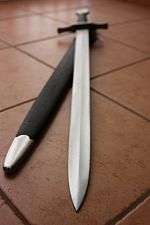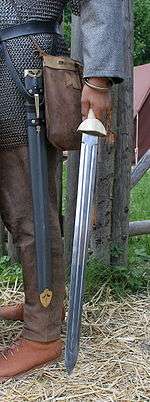Sword replica
Sword replicas may be produced as a singular reproduction of a specific historical sword, e.g. commissioned by a museum, or they may be produced commercially in series, again either based on a specific sword, a certain historical type of sword, or an original design loosely based on historical precedents. Functional quality reproductions even when produced in series may be priced in the USD/EUR 1,000 to 2,000 range or above, while cheap factory produced swords may range around USD/EUR 50 to 200.
The purpose of the replica may be either exhibition (educational museum replicas, or simply decorative "wallhangers"), or practical use (historical fencing, combat reenactment, kenjutsu/battōjutsu or test cutting).
In the case of decorative replicas, the product need not be able to withstand the physical stress of actual use, resulting in lower cost. Such decorative look-alikes are also pejoratively referred to as "sword-like objects" (or SLOs) in jargon, especially when falsely advertised.
Swords intended for historical fencing on the other hand should ideally come as closely as possible to historical weapons (but remain unsharpened to avoid injury). Swords used for test cutting are sharpened, and are often heavier than their historical counterparts, since added weight improves their cutting effect at the expense of agility (cf. the historical executioner's swords). Swords used for combat reenactment often have rounded points to reduce the risk of injury, and are also often much heavier than their historical counterparts.
Anatomy of a sword replica
Many cheap modern sword replicas are built for decorative purposes. These are either too brittle or too fragile for any practical use.
Materials
Historical sword blades are always made of carbon steel alloys, but many replicas are not. Often the choice of blade material has more to do with ease of manufacture or marketing than sword performance.
Decorative swords often have low quality stainless steel blades. This is because stainless steel will not rust when on display and lower grades are cheap. A stainless steel blade made of cheaper materiel with a small flaw or a poor heat treatment can be brittle and shatter on impact with a target, potentially resulting in injury to the attacker as well as the target.
Some replica swords are nickel or chrome plated to prevent corrosion. This plating is often far shinier than even highly polished carbon steel blades making the swords poor reproductions. The plating itself isn't very durable and can chip or flake if the swords are actually used for anything other than display.
Weight and balance
Replica swords are generally consumer display items. Blades are often stamped or cut from steel blanks so that they don't taper properly. Shortcuts are often taken with the blade tang and hilt fittings so they rarely counterbalance the blade properly. This often makes for a sword that is both heavier than its historical counterpart and much more blade heavy in terms of balance.
Many sword replicas touted as "battle ready" are also overbuilt making them unhistorically robust and heavy. They will not break even under stress that would destroy a historical sword, but they also lack the proper weight and balance of a historical sword. This makes them unwieldy and unsuited for many types of swordplay.
Hilt construction
The weakest point of most sword replicas is the hilt or handle. The part of the blade which protrudes into the handle and attaches the two together is called the blade tang. The blade tang transfers impact from the blade to the wielders hands. Many manufactures of replicas use inferior types of tangs, which is one of the most common causes of various forms of breakage or product failure.
Historical swords have a tang that was forged as part of the blade, which is hammered through the hilt, or peened; the sword-maker then files the protrusion. Threaded tangs are tangs that, despite having been forged as part of the sword, are inferior since they are screwed into the hilt rather than properly peened. Tab tangs are much shorter than full tangs and often fix the blade to the hilt with friction, glue, or single pin. Rat tail tangs are thin tangs welded to the blade. Partial tangs have a thick blade tang which transitions to a rat tail at some point within the hilt.
These less durable tang designs are liable to break or bend when struck against anything. Worse still, the blade can come loose from the handle when the sword is swung and potentially injure someone. The proper tang has to be designed and heat treated to prevent breaking, bending, or conducting hand numbing vibration from impacts to the user.
Use
Sword replicas are widely distributed and sold around the world, even in countries that try to restrict weapons. As such, even low-end ornamental swords can be used as weapons in assaults and robberies.
Manufacturers
Notable companies manufacturing sword replicas include:
- Albion Swords (USA)
- Atlanta Cutlery Corp. (USA)
- Hanwei (China)
- Windlass Steelcrafts (India)
- Cold Steel (USA)
- Deepeeka (India)
- Darksword Armory (Canada)
- Universal Swords (India)
- Del Tin (Italy)
- Arms & Armor (USA)
- Swords Kingdom (USA)
- Swords Kingdom UK (UK)
Gallery
 Hero sword (film merchandise)
Hero sword (film merchandise) "Agincourt sword" (Hanwei)
"Agincourt sword" (Hanwei) replica of a 4th-century Roman spatha made by Deepeeka of India
replica of a 4th-century Roman spatha made by Deepeeka of India a Seax replica together with its 7th century original.
a Seax replica together with its 7th century original.
References
- Michael 'Tinker' Pearce, The Medieval Sword in the Modern World (2007), ISBN 978-1-4303-2801-8